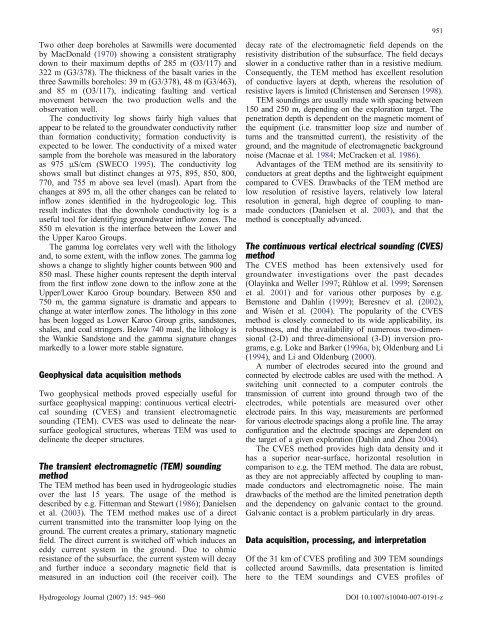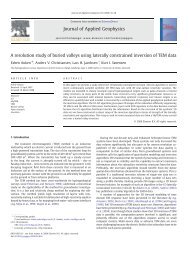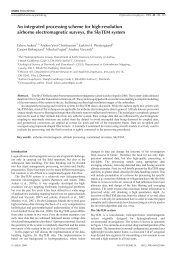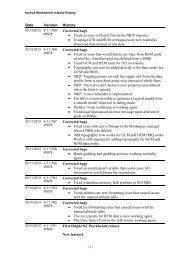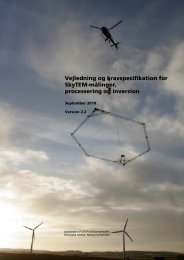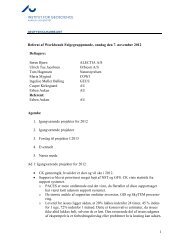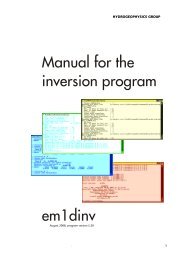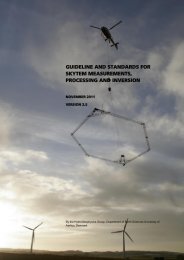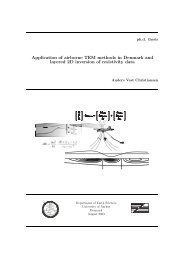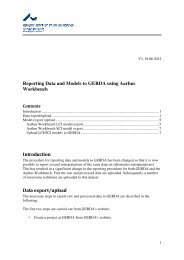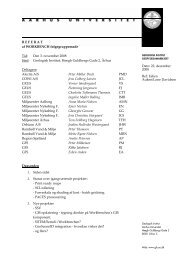Geophysical and hydrogeologic investigation of groundwater in the ...
Geophysical and hydrogeologic investigation of groundwater in the ...
Geophysical and hydrogeologic investigation of groundwater in the ...
- No tags were found...
You also want an ePaper? Increase the reach of your titles
YUMPU automatically turns print PDFs into web optimized ePapers that Google loves.
Two o<strong>the</strong>r deep boreholes at Sawmills were documentedby MacDonald (1970) show<strong>in</strong>g a consistent stratigraphydown to <strong>the</strong>ir maximum depths <strong>of</strong> 285 m (O3/117) <strong>and</strong>322 m (G3/378). The thickness <strong>of</strong> <strong>the</strong> basalt varies <strong>in</strong> <strong>the</strong>three Sawmills boreholes: 39 m (G3/378), 48 m (G3/463),<strong>and</strong> 85 m (O3/117), <strong>in</strong>dicat<strong>in</strong>g fault<strong>in</strong>g <strong>and</strong> verticalmovement between <strong>the</strong> two production wells <strong>and</strong> <strong>the</strong>observation well.The conductivity log shows fairly high values thatappear to be related to <strong>the</strong> <strong>groundwater</strong> conductivity ra<strong>the</strong>rthan formation conductivity; formation conductivity isexpected to be lower. The conductivity <strong>of</strong> a mixed watersample from <strong>the</strong> borehole was measured <strong>in</strong> <strong>the</strong> laboratoryas 975 μS/cm (SWECO 1995). The conductivity logshows small but dist<strong>in</strong>ct changes at 975, 895, 850, 800,770, <strong>and</strong> 755 m above sea level (masl). Apart from <strong>the</strong>changes at 895 m, all <strong>the</strong> o<strong>the</strong>r changes can be related to<strong>in</strong>flow zones identified <strong>in</strong> <strong>the</strong> <strong>hydrogeologic</strong> log. Thisresult <strong>in</strong>dicates that <strong>the</strong> downhole conductivity log is auseful tool for identify<strong>in</strong>g <strong>groundwater</strong> <strong>in</strong>flow zones. The850 m elevation is <strong>the</strong> <strong>in</strong>terface between <strong>the</strong> Lower <strong>and</strong><strong>the</strong> Upper Karoo Groups.The gamma log correlates very well with <strong>the</strong> lithology<strong>and</strong>, to some extent, with <strong>the</strong> <strong>in</strong>flow zones. The gamma logshows a change to slightly higher counts between 900 <strong>and</strong>850 masl. These higher counts represent <strong>the</strong> depth <strong>in</strong>tervalfrom <strong>the</strong> first <strong>in</strong>flow zone down to <strong>the</strong> <strong>in</strong>flow zone at <strong>the</strong>Upper/Lower Karoo Group boundary. Between 850 <strong>and</strong>750 m, <strong>the</strong> gamma signature is dramatic <strong>and</strong> appears tochange at water <strong>in</strong>terflow zones. The lithology <strong>in</strong> this zonehas been logged as Lower Karoo Group grits, s<strong>and</strong>stones,shales, <strong>and</strong> coal str<strong>in</strong>gers. Below 740 masl, <strong>the</strong> lithology is<strong>the</strong> Wankie S<strong>and</strong>stone <strong>and</strong> <strong>the</strong> gamma signature changesmarkedly to a lower more stable signature.<strong>Geophysical</strong> data acquisition methodsTwo geophysical methods proved especially useful forsurface geophysical mapp<strong>in</strong>g: cont<strong>in</strong>uous vertical electricalsound<strong>in</strong>g (CVES) <strong>and</strong> transient electromagneticsound<strong>in</strong>g (TEM). CVES was used to del<strong>in</strong>eate <strong>the</strong> nearsurfacegeological structures, whereas TEM was used todel<strong>in</strong>eate <strong>the</strong> deeper structures.The transient electromagnetic (TEM) sound<strong>in</strong>gmethodThe TEM method has been used <strong>in</strong> <strong>hydrogeologic</strong> studiesover <strong>the</strong> last 15 years. The usage <strong>of</strong> <strong>the</strong> method isdescribed by e.g. Fitterman <strong>and</strong> Stewart (1986); Danielsenet al. (2003). The TEM method makes use <strong>of</strong> a directcurrent transmitted <strong>in</strong>to <strong>the</strong> transmitter loop ly<strong>in</strong>g on <strong>the</strong>ground. The current creates a primary, stationary magneticfield. The direct current is switched <strong>of</strong>f which <strong>in</strong>duces aneddy current system <strong>in</strong> <strong>the</strong> ground. Due to ohmicresistance <strong>of</strong> <strong>the</strong> subsurface, <strong>the</strong> current system will decay<strong>and</strong> fur<strong>the</strong>r <strong>in</strong>duce a secondary magnetic field that ismeasured <strong>in</strong> an <strong>in</strong>duction coil (<strong>the</strong> receiver coil). TheHydrogeology Journal (2007) 15: 945–960decay rate <strong>of</strong> <strong>the</strong> electromagnetic field depends on <strong>the</strong>resistivity distribution <strong>of</strong> <strong>the</strong> subsurface. The field decaysslower <strong>in</strong> a conductive ra<strong>the</strong>r than <strong>in</strong> a resistive medium.Consequently, <strong>the</strong> TEM method has excellent resolution<strong>of</strong> conductive layers at depth, whereas <strong>the</strong> resolution <strong>of</strong>resistive layers is limited (Christensen <strong>and</strong> Sørensen 1998).TEM sound<strong>in</strong>gs are usually made with spac<strong>in</strong>g between150 <strong>and</strong> 250 m, depend<strong>in</strong>g on <strong>the</strong> exploration target. Thepenetration depth is dependent on <strong>the</strong> magnetic moment <strong>of</strong><strong>the</strong> equipment (i.e. transmitter loop size <strong>and</strong> number <strong>of</strong>turns <strong>and</strong> <strong>the</strong> transmitted current), <strong>the</strong> resistivity <strong>of</strong> <strong>the</strong>ground, <strong>and</strong> <strong>the</strong> magnitude <strong>of</strong> electromagnetic backgroundnoise (Macnae et al. 1984; McCracken et al. 1986).Advantages <strong>of</strong> <strong>the</strong> TEM method are its sensitivity toconductors at great depths <strong>and</strong> <strong>the</strong> lightweight equipmentcompared to CVES. Drawbacks <strong>of</strong> <strong>the</strong> TEM method arelow resolution <strong>of</strong> resistive layers, relatively low lateralresolution <strong>in</strong> general, high degree <strong>of</strong> coupl<strong>in</strong>g to manmadeconductors (Danielsen et al. 2003), <strong>and</strong> that <strong>the</strong>method is conceptually advanced.The cont<strong>in</strong>uous vertical electrical sound<strong>in</strong>g (CVES)methodThe CVES method has been extensively used for<strong>groundwater</strong> <strong><strong>in</strong>vestigation</strong>s over <strong>the</strong> past decades(Olay<strong>in</strong>ka <strong>and</strong> Weller 1997; Rühlow et al. 1999; Sørensenet al. 2001) <strong>and</strong> for various o<strong>the</strong>r purposes by e.g.Bernstone <strong>and</strong> Dahl<strong>in</strong> (1999); Beresnev et al. (2002),<strong>and</strong> Wisén et al. (2004). The popularity <strong>of</strong> <strong>the</strong> CVESmethod is closely connected to its wide applicability, itsrobustness, <strong>and</strong> <strong>the</strong> availability <strong>of</strong> numerous two-dimensional(2-D) <strong>and</strong> three-dimensional (3-D) <strong>in</strong>version programs,e.g. Loke <strong>and</strong> Barker (1996a, b); Oldenburg <strong>and</strong> Li(1994), <strong>and</strong> Li <strong>and</strong> Oldenburg (2000).A number <strong>of</strong> electrodes secured <strong>in</strong>to <strong>the</strong> ground <strong>and</strong>connected by electrode cables are used with <strong>the</strong> method. Aswitch<strong>in</strong>g unit connected to a computer controls <strong>the</strong>transmission <strong>of</strong> current <strong>in</strong>to ground through two <strong>of</strong> <strong>the</strong>electrodes, while potentials are measured over o<strong>the</strong>relectrode pairs. In this way, measurements are performedfor various electrode spac<strong>in</strong>gs along a pr<strong>of</strong>ile l<strong>in</strong>e. The arrayconfiguration <strong>and</strong> <strong>the</strong> electrode spac<strong>in</strong>gs are dependent on<strong>the</strong> target <strong>of</strong> a given exploration (Dahl<strong>in</strong> <strong>and</strong> Zhou 2004).The CVES method provides high data density <strong>and</strong> ithas a superior near-surface, horizontal resolution <strong>in</strong>comparison to e.g. <strong>the</strong> TEM method. The data are robust,as <strong>the</strong>y are not appreciably affected by coupl<strong>in</strong>g to manmadeconductors <strong>and</strong> electromagnetic noise. The ma<strong>in</strong>drawbacks <strong>of</strong> <strong>the</strong> method are <strong>the</strong> limited penetration depth<strong>and</strong> <strong>the</strong> dependency on galvanic contact to <strong>the</strong> ground.Galvanic contact is a problem particularly <strong>in</strong> dry areas.Data acquisition, process<strong>in</strong>g, <strong>and</strong> <strong>in</strong>terpretation951Of <strong>the</strong> 31 km <strong>of</strong> CVES pr<strong>of</strong>il<strong>in</strong>g <strong>and</strong> 309 TEM sound<strong>in</strong>gscollected around Sawmills, data presentation is limitedhere to <strong>the</strong> TEM sound<strong>in</strong>gs <strong>and</strong> CVES pr<strong>of</strong>iles <strong>of</strong>DOI 10.1007/s10040-007-0191-z


